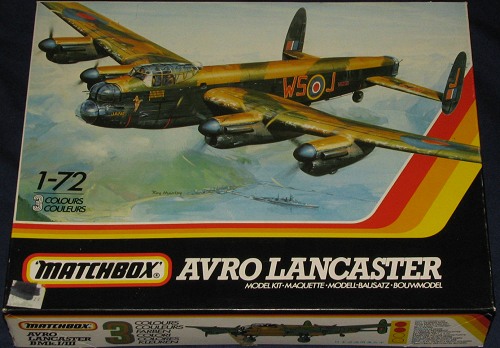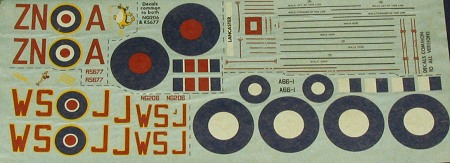
| KIT: | Matchbox 1/72 Avro Lancaster |
| KIT #: | PK 602 |
| PRICE: | $8-10 or even less at swap meets. Currently OOP |
| DECALS: | Three options |
| REVIEWER: | Scott Van Aken |
| NOTES: | Gotta love the multi-colored plastic! |

| HISTORY |
The third aircraft in the RAF's bomber 'trifecta' was the Avro Lancaster. Developed from the Manchester, a twin engine bomber whose fate was sealed by the very troublesome Vulture engines that powered it, the Lancaster was basically the same plane, but with four Merlins. It was the addition of these engines as well as some airframe refinements that produced what many consider the British's finest bomber of the war (though some Halifax fans may dispute that).
The aircraft was also exported after the war to a number of countries including Canada (who also built the aircraft), Australia and Argentina. It was also further developed into the Griffon powered Lincoln, a plane that was used by the Australians against insurgents in Malaya with mixed results. To my knowledge, there are still two of these planes airworthy, one in the UK and another in Canada.
| THE KIT |
 You
have to love Matchbox kits. They were originally designed for kid's pocket
money, but many older model builders have fallen under their charms as
well. Two things set these kits apart from others. One is the use of
multi-colored plastic sprues. Undoubtedly this is so that the kiddies don't
have to paint them, but probably just to add to the kid-appeal of the kits.
The other is that most Matchbox kits I've built, have fit very well. Well,
let me broaden that a bit. For a kid, they fit well. The joins are a bit on
the large side and the older modeler will break out the filler for these
and perhaps for the panel lines as well. These are engraved, but rather
large in comparison to today's kits.
You
have to love Matchbox kits. They were originally designed for kid's pocket
money, but many older model builders have fallen under their charms as
well. Two things set these kits apart from others. One is the use of
multi-colored plastic sprues. Undoubtedly this is so that the kiddies don't
have to paint them, but probably just to add to the kid-appeal of the kits.
The other is that most Matchbox kits I've built, have fit very well. Well,
let me broaden that a bit. For a kid, they fit well. The joins are a bit on
the large side and the older modeler will break out the filler for these
and perhaps for the panel lines as well. These are engraved, but rather
large in comparison to today's kits.
Overall detail is not bad, but not very extensive. You won't find such amenities as a fully detailed cockpit or boxed in wheel wells. This is a 1970's kit, you know. In fact, the cockpit really consists of nothing more than a seat shape, control column and some figures to stick in the seats. An aftermarket etched set is mandatory for those wanting any detail level at all in the front office. Transparencies are rather thick, so perhaps any work done on the cockpit will be wasted without a replacement vac canopy. You can build the bomb bay open should you wish, but there is nothing to see so most will cement the doors closed. There are two different sets of doors depending on the markings used. An H2S radar pod is provided for the Aussie plane. An upper turret is provided for two of the schemes. The box art aircraft doesn't use it. Not surprising as these planes were mostly used at night and statistics show that less than 10% of bombers shot down by night fighters actually saw the planes that downed them. In fact, the night bombers could have done away with defensive armament and gunners completely, providing lighter aircraft with room for more fuel, more ordnance or providing higher speeds.
 Instructions are completely
pictorial with 18 well drawn construction steps. As was the norm with
Matchbox, any detail painting is provided in a separate chart. All color
information is generic. It calls for the wheel wells and bomb bay to be
painted black and I'm not sure that is correct. I'd have thought British
Interior Green to be the color of choice for these areas. Markings are
provided for three aircraft. One is box art aircraft of 9 Sq with bulged
bomb bay doors (for carrying the 'tall boy' 12,000 bomb. This one has no
upper turret. The other RAF plane is from 106 Squadron in Sept 1942, making
it one of the first operational units on the Lancaster. These two planes
are in the night scheme of Dark Earth/Dark Green over black. The third
option is an aluminum painted Australian aircraft that also has the H2S
bombing radar. Decals will prove to be somewhat thick, but since my set
still hasn't yellowed, they should work without any problems.
Instructions are completely
pictorial with 18 well drawn construction steps. As was the norm with
Matchbox, any detail painting is provided in a separate chart. All color
information is generic. It calls for the wheel wells and bomb bay to be
painted black and I'm not sure that is correct. I'd have thought British
Interior Green to be the color of choice for these areas. Markings are
provided for three aircraft. One is box art aircraft of 9 Sq with bulged
bomb bay doors (for carrying the 'tall boy' 12,000 bomb. This one has no
upper turret. The other RAF plane is from 106 Squadron in Sept 1942, making
it one of the first operational units on the Lancaster. These two planes
are in the night scheme of Dark Earth/Dark Green over black. The third
option is an aluminum painted Australian aircraft that also has the H2S
bombing radar. Decals will prove to be somewhat thick, but since my set
still hasn't yellowed, they should work without any problems.
| CONCLUSIONS |
Though this kit will soon be overshadowed by the upcoming Hasegawa release, it was in many ways the best of those available as both the Revell and Airfix kits are not only festooned with rivets, but are not easy builds. If you are a new modeler and want a relatively hassle-free build, then this is one that can be recommended to you.
Late Note: I've been informed by several readers that Airfix remolded the Lancaster in 1980 and they consider it to be a more accurate kit than the Matchbox version. They also acknowledge that the older mold Airfix kit and the Revell kit (as well as a Frog version), were not as good as the Matchbox.
June 2005
Kit courtesy of my ability to scrounge the vendors at shows.
If you would like your product reviewed fairly and quickly by a site that has nearly 300,000 visitors a month, please contact me or see other details in the Note to Contributors.